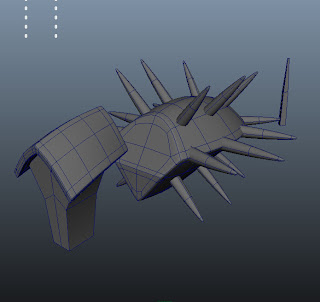As with Arm and Leg, started by exporting and straightening the block-out model tail.
The carapace on each vertebra was refined by bevelling the edge loop round the center, then adding edge loops to sharpen the edges (same technique as used on the torso carapace plates)
Spikes added to tail club; to keep polygon count down, each spike is a cylinder with only 4 axis divisions.
Vertebrae
Block-out model used as a guide for refined model, with added chain guides and pulleys for mechanism. Shape based off dinosaur vertebrae.
Articulation
Since the conection between vertebrae wasn't worked out in the concept picture or silhouettes, I brainstormed for a design that would allow enough movement. Ball and socket designs didn't match the sharp-edged design of the rest of the model, so I ended up with a symetrical hinge arrangement.
Modelled connection.
Added connection point to vertebra
Duplicated and transformed master vertebra to make rest of tail
Tail Club connection
Trying out different designs for attaching the tail to the club. Although the top one looks stronger, I prefer the look of the lower design.





























































